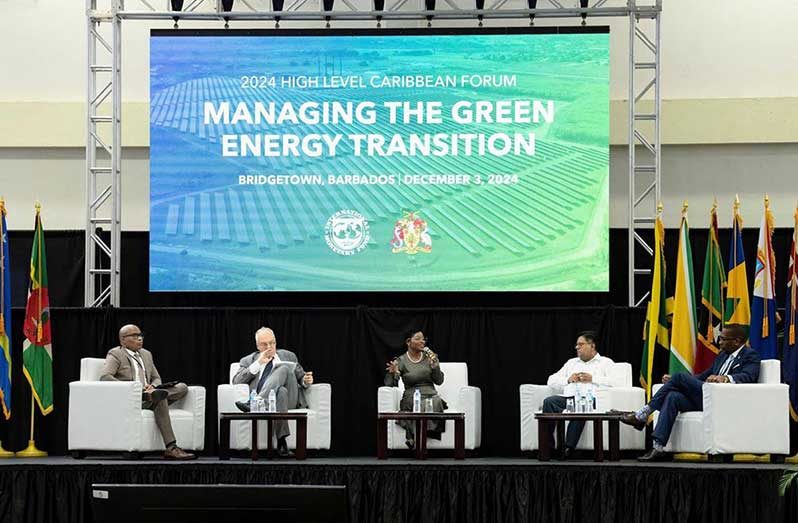–as IMF meets to discuss managing the transition from fossil fuels to ‘green’ energy
YEARS after it was first introduced as a potential means of combatting climate change, Guyana’s Low-Carbon Development Strategy (LCDS) is still the talk of the town, so to speak, in terms of its innovative approach to managing its forests.
The subject arose just last week during the International Monetary Fund (IMF)’s 2024 High Level Caribbean Forum on Managing the ‘Green’ Transition.
The forum reportedly brought together government ministers, regional Central Bank governors, private sector and other stakeholders, the IMF Managing Director and senior IMF officials to discuss the Green Energy Transition (GET), which entails reducing the world’s reliance on fossil fuels by shifting to a renewable energy mix, while using existing energy more efficiently.
Senior Minister in the Office of the President with Responsibility for Finance and the Public Service, Dr. Ashni Singh, who was a participant in a panel discussion titled, “Taking Stock of the Macroeconomic Implications of the Green Energy Transition”, began his presentation by reminding the forum that the Caribbean Region accounts for only 0.2 per cent of Global Greenhouse Gases, and is disproportionately and highly exposed to climate change and natural disasters.
According to a release from the Ministry of Finance, he also brought to the attention of fellow participants “that the Caribbean Region is seven times more at risk of facing a natural disaster than larger States, is twice as prone to natural disasters as other small States elsewhere, and that natural disasters impose a disproportionate extent of damage, for instance where one hurricane can impose damage of more than 200 per cent of Gross Domestic Product (GDP)”.
And, with respect to the critical issue in energy transition of access to financing, he seized the opportunity to call on the multilateral community “to do more to increase the volume of financing available for public and private investments in the energy transition, and to reduce the cost of these investments, including through the use of derisking instruments”.
IMF Managing Director Kristalina Georgieva, during her opening remarks, cautioned the forum that Climate Change does pose an acute threat to the Caribbean, as evinced by the frequency and intensity with which natural disasters are occurring.
As such, she pointed out that rapid global transition to renewable energy is essential to mitigate some of these climate challenges.
The IMF official, however, posited that despite the challenges, she firmly believes that the Caribbean region has tremendous opportunity, what with their economies showing incredible resilience through the pandemic and its aftermath.
“Now is the time to seize the opportunity provided by global developments to plan and coordinate a green energy transition that fosters inclusive, sustainable, and resilient growth across the region,” she advised.
At this point, Ms. Georgieva pointed to the substantial financial resources required for this transition as she indicated that Caribbean governments alone cannot bear the burden with the cost for resilience building in the Caribbean region estimated at a staggering US$100 billion over the next two decades.
“This is the moment to leverage innovative financial instruments such as Guyana’s sale of carbon credits,” she then advised the forum as she alluded to Guyana’s recent ambitious and innovative approach to garner funds for the country using its forests.
While attending the forum, Minister Singh also held bilateral discussions with the IMF’s Managing Director, updating her on recent economic developments in Guyana, and the very favourable economic prospects of the country, looking ahead.
Guyana has outlined a second-generation LCDS as a successor to its first LCDS, which aims to reduce the country’s reliance on heavy fuel oil and transition to cleaner, more affordable energy sources, as well as mobilise resources from domestic assets.
Under the first LCDS, the global climate services provided by Guyana’s standing forests were mobilised to generate revenue for the country, in this instance, under a US$250 million bilateral partnership with the Kingdom of Norway.
On December 1, 2022, the Architecture for REDD+ Transactions announced the issuance of US$33.47 million TREES credit to Guyana for the five-year period from 2016 to 2020. The Architecture for REDD+ Transactions (ART) is a global initiative that seeks to incentivise the reducing of emissions from
deforestation and forest degradation (REDD), as well as restore forests and protect intact forests. Subsequently, Government entered into an agreement whereby Hess Corporation purchased approximately a third of Guyana’s credits. The agreement sets out that Hess will buy 2.5 million credits per year for 2016 to 2030 to a total of 37.5 million credits for a minimum payment of US$750 million to be paid to Guyana between 2022 and 2032
On February 28 this year as well, Guyana announced the issuance of the world’s first carbon credits eligible for use by airlines in Phase 1 of CORSIA – the United Nations’ International Civil Aviation Organisation (ICAO)’s global emissions reduction programme. The credits issued were for Guyana’s 2021 performance in sustaining one of the world’s highest levels of tropical forest coverage, and one of the world’s lowest deforestation rates. A total of 7.14 million credits were issued by the Architecture for REDD+ Transactions (ART) for conformance with ART’s “TREES” standard.



.jpg)











